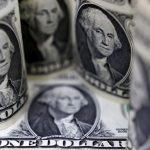LONDON/TOKYO (Reuters) -The dollar ticked up on Tuesday after falling to its lowest against the euro, sterling and Swiss franc since mid-March overnight as signs of a softening U.S. economy boosted the case for earlier Federal Reserve interest rate cuts.
Investors were looking towards U.S. job openings data later in the day, which will provide an insight into the state of the labour market and could push the U.S. currency lower.
The euro rose as high as $1.0916 for the first time since March 21 in the Asian trading session, but gave up some ground to stand 0.2% lower at $1.0886.
Sterling hit its highest since mid-March too at $1.2818 but was also last down 0.2%.
As the U.S. currency found a footing, the dollar index was up 0.12% at 104.16, having fallen to its lowest since mid-April overnight at 103.99.
Data on Monday showed a second straight month of slowdown in manufacturing activity and an unexpected decline in construction spending, causing the dollar index to fall around 0.6%.
“The dollar is starting to show signs of weakness,” said Chris Turner, global head of markets at lender ING. “Today’s US JOLTS job openings data could determine whether recent dollar losses are… the start of an important new trend.”
The U.S. job openings and labour turnover survey (JOLTS) is due out at 1400 GMT, or 10 a.m. ET, and will show the number of vacancies in May. It will also report on the number of people voluntarily quitting their job.
“This figure had surged through the pandemic as tight labour markets prompted staff to quit jobs in search of higher pay,” said Turner. “This piece of data is seen to have a good lead on wage inflation.”
Japan’s yen bucked the trend on Tuesday and continued to rise against the dollar after climbing on Monday, with the U.S. currency down 0.43% at 155.34, its weakest in two weeks.
Bank of Japan Deputy Governor Ryozo Himino said on Tuesday the central bank must be “very vigilant” to the impact the yen’s fluctuations could have on the economy and inflation in guiding monetary policy.
Back in Europe, the dollar fell 0.2% to its lowest against the Swiss franc since mid-March at 0.8938 francs. Data showed Swiss inflation held steady at 1.4% year-on-year in May.
The U.S. currency’s decline against its peers has been driven by investors raising their bets on Federal Reserve rate cuts this year, which has pulled down Treasury yields, making U.S. debt look less attractive.
Markets increased the chances of a rate cut in September to around 59.1% on Tuesday, according to LSEG data on derivatives prices. That compares with odds of around 55% on Friday and slightly below 50% earlier last week.

The European Central Bank has telegraphed that policymakers will cut rates at their meeting on Thursday, but a pick-up in inflation in data last week may give officials pause when considering when next to ease.
Investors were also keeping an eye on India’s rupee as election results come in, with the currency down on Tuesday amid a lack of clarity about the performance of the alliance led by Indian Prime Minister Narendra Modi.
To read the full article, Click Here

